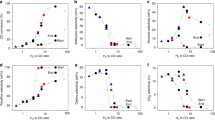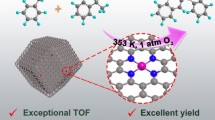Abstract
The need for a sustainable energy supply in the face of depleting oil reserves has reignited the importance of Fischer–Tropsch (FT) synthesis technology. Presently, the FT process is practiced at the industrial scale to predominately produce synthetic diesel-type fuels and lubricants. More recently, the possibility of hydrogenating CO toward oxygenates, and not just hydrocarbons, has been explored. We have developed a series of CoCuMn and CoMnK catalysts prepared via the oxalate co-precipitation route that are capable of forming oxygenates with desirable selectivity. Upon H2-assisted thermal decomposition of the resultant mixed metal Co1Cu1Mn1 oxalates, catalysts naturally exhibited a cobalt core–copper shell configuration with Mn5O8 dispersed throughout the catalyst nanoparticle as determined via Atom Probe Tomography (APT). We suggest structural changes are induced by the CO and H2 reactants to form the catalytically active phase under real-time reaction conditions as demonstrated by corroborative Density Functional Theory calculations and experimental evidence. APT studies also show that a Co4Mn1K0.1 catalyst post reaction contained a cobalt carbide phase as determined from a Co/C ratio of 2/1. Manganese and potassium were found only in the outermost part of the particle. Both catalysts were found to contain the presence of a Mn5O8 oxidic phase before and post reaction which we attribute to the high activity toward oxygenates of these two catalysts.






Similar content being viewed by others
References
Fischer F, Tropsch H (1926) Über Die Direkte Synthese von Erdöl- Kohlenwasserstoffen Bei Gewöhnlichem Druck. (Erste Mitteilung). Eur J Inorg Chem 59:830–831
BASF (1913) Und Soda-Fabrik, Ludwigshafen a. German patent DE 2,93,787
Leckel D (2009) Diesel production from Fischer–Tropsch: the past, the present, and new concepts. Energy Fuels 23:2342–2358. https://doi.org/10.1021/ef900064c
Hindermann JP, Hutchings GJ, Kiennemann A (1993) Mechanistic aspects of the formation of hydrocarbons and alcohols from CO hydrogenation. Catal Rev 35:1–127. https://doi.org/10.1080/01614949308013907
Dean JA (1972) Lange’s handbook of chemistry. McGraw Hill, New York
Xiaoding X, Doesburg EBM, Scholten JJF (1987) Synthesis of higher alcohols from syngas—recently patented catalysts and tentative ideas on the mechanism. Catal Today 2:125–170. https://doi.org/10.1016/0920-5861(87)80002-0
Pan X, Fan Z, Chen WEI, Ding Y, Luo H, Bao X (2007) Enhanced ethanol production inside carbon-nanotube reactors containing catalytic particles. Nat Mater 6:507–511. https://doi.org/10.1038/nmat1916
Burch R, Petch MI (1992) Investigation of the synthesis of oxygenates from carbon monoxide/hydrogen mixtures on supported rhodium catalysts. Appl Catal A 88:39–60. https://doi.org/10.1016/0926-860X(92)80195-I
Xiang M, Li D, Xiao H, Zhang J, Qi H, Li W, Zhong B, Sun Y (2008) Synthesis of higher alcohols from syngas over Fischer–Tropsch elements modified K/β-Mo2C catalysts. Fuel 8:599–603. https://doi.org/10.1016/j.fuel.2007.01.041
Luk HT, Mondelli C, Ferré DC, Stewart JA, Pérez-Ramírez J (2017) Status and prospects in higher alcohols synthesis from syngas. Chem Soc Rev 46:1358–1426. https://doi.org/10.1039/C6CS00324A
Schulz H (1999) Short history and present trends of Fischer–Tropsch synthesis. Appl Catal A 186:3–12. https://doi.org/10.1016/S0926-860X(99)00160-X
Forzatti P, Tronconi E, Pasquon I (1991) Higher alcohol synthesis. Catal Rev 33:109–168. https://doi.org/10.1080/01614949108020298
Subramani V, Gangwal SK (2008) A review of recent literature to search for an efficient catalytic process for the conversion of syngas to ethanol. Energy Fuels 8:814–839. https://doi.org/10.1021/ef700411x
Fang K, Li D, Lin M, Xiang M, Wei W, Sun Y(2009) A short review of heterogeneous catalytic process for mixed alcohols synthesis via syngas. Catal Lett 147:133–138. https://doi.org/10.1016/j.cattod.2009.01.038
Woo HC, Park KY, Kim YG, Nam I, Shik J, Lee JS (1991) Mixed alcohol synthesis from carbon monoxide and dihydrogen over potassium-promoted molybdenum carbide catalysts. Appl Catal 75:267–280. https://doi.org/10.1016/S0166-9834(00)83136-X
Zaman S, Smith KJ (2012) A review of molybdenum catalysts for synthesis gas conversion to alcohols: catalysts, mechanisms and kinetics. Catal Rev 54:41–132. https://doi.org/10.1080/01614940.2012.627224
Luk HT, Mondelli C, Ferré DC, Stewart JA, Pérez-ramírez J (2017) Status and prospects in higher alcohols synthesis from syngas. Chem Soc Rev 46:1358–1426. https://doi.org/10.1039/C6CS00324A
Sugier A, Freund E (1978) Process for manufacturing alcohols, particularly linear saturated primary alcohols, from synthesis gas. US patent 4122110
Courty P, Durand D, Freund E, Sugier A (1982) C1–C6 alcohols from synthesis gas on copper–cobalt catalysts. J Mol Catal 17:241–254. https://doi.org/10.1016/0304-5102(82)85035-9
Xiang Y, Kruse N (2016) Cobalt–copper based catalysts for higher terminal alcohols synthesis via Fischer–Tropsch reaction. J Energy Chem 25:895–906. https://doi.org/10.1016/j.jechem.2016.09.014
Xiang Y, Kruse N (2016) Tuning the catalytic CO hydrogenation to straight- and long-chain aldehydes/alcohols and olefins/paraffins. Nat Commun 7:13058. https://doi.org/10.1038/ncomms13058
Xiang Y, Barbosa R, Li X, Kruse N (2015) Ternary cobalt–copper–niobium catalysts for the selective CO hydrogenation to higher alcohols. ACS Catal 5:2929–2934. https://doi.org/10.1021/acscatal.5b00388
Zhong L, Yu F, An Y, Zhao Y, Sun Y, Li Z, Lin T, Lin Y, Qi X, Dai Y, Gu L, Hu J, Jin S, Shen Q, Wang H (2016) Cobalt carbide nanoprisms for direct production of lower olefins from syngas. Nature 538:84–87. https://doi.org/10.1038/nature19786
Collinge G, Xiang Y, Barbosa R, McEwen J-S, Kruse N (2016) CO-induced inversion of the layer sequence of a model CoCu catalyst. Surf Sci 648:74–83. https://doi.org/10.1016/j.susc.2015.10.014
Nishizawa T, Ishida K (1984) The Co–Cu (cobalt–copper) system. Bull APD 5:161–165. https://doi.org/10.1520/D0850-11.1
Xiang Y, Barbosa R, Kruse N (2014) Higher alcohols through CO hydrogenation over CoCu catalysts: influence of precursor activation. ACS Catal 4:2792–2800. https://doi.org/10.1021/cs500696z
Beaumont SK, Alayoglu S, Pushkarev VV, Liu Z, Somorjai GA (2013) Exploring surface science and restructuring in reactive atmospheres of colloidally prepared bimetallic CuNi and CuCo nanoparticles on SiO2 in situ using ambient pressure X-ray photoelectron spectroscopy. RSC 162:31–44. https://doi.org/10.1039/c2fd20145c
Sci C, Fischer P, Spivey JJ (2012) A DRIFTS Study of CO adsorption and hydrogenation on Cu-based core–shell nanoparticles. Catal Sci Technol 2:621–631. https://doi.org/10.1039/c2cy00413e
Musselwhite N, Brooks CJ, Marcus MA, Guo J, Liu Z, Kruse N, Somorjai GA (2013) Surface composition changes of redox stabilized bimetallic CoCu nanoparticles supported on silica under H2 and O2 atmospheres and during reaction between CO2 and H2: in situ X-ray spectroscopic characterization. J Phys Chem C 117:21803–21809. https://doi.org/10.1021/jp405745n
Xiang Y, Chitry V, Liddicoat P, Felfer P, Cairney J, Ringer S, Kruse N (2013) Long-chain terminal alcohols through catalytic CO hydrogenation. J Am Chem Soc 135:7114–7117. https://doi.org/10.1021/ja402512r
Falo F, Cano I, Salmerón M (1984) CO chemisorption on two-dimensional cobalt clusters: a surface science approach to cluster chemistry. Surf Sci 143:303–313
Carenco S, Tuxen A, Chintapalli M, Pach E, Escudero C, Ewers TD, Jiang P, Borondics F, Thornton G, Alivisatos AP, Bluhm H, Guo J, Salmeron M (2013) Dealloying of cobalt from CuCo nanoparticles under syngas exposure. J Phys Chem C 117:6259–6266. https://doi.org/10.1021/jp4000297
Lebarbier VM, Mei D, Kim DH, Andersen A, Male JL, Holladay JE, Rousseau R, Wang Y (2011) Effects of La2O3 on the mixed higher alcohols synthesis from syngas over Co catalysts: a combined theoretical and experimental study. J Phys Chem C 115:17440–17451. https://doi.org/10.1021/jp204003q
Wang Z, Spivey JJ (2015) General effect of ZrO2, Al2O3 and La2O3 on cobalt–copper catalysts for higher alcohols synthesis. Gen Appl Catal A 507:75–81. https://doi.org/10.1016/j.apcata.2015.09.032
Volkova GG, Yurieva TM, Plyasova LM, Naumova MI, Zaikovskii VI (2000) Role of the Cu–Co alloy and cobalt carbide in higher alcohol synthesis. J Mol Catal A 158:389–393. https://doi.org/10.1016/S1381-1169(00)00110-2
Pei YP, Liu JX, Zhao YH, Ding YJ, Liu T, Dong WD, Zhu HJ, Su HY, Yan L, Li JL, Li WX (2015) High alcohols synthesis via Fischer–Tropsch reaction at cobalt metal/carbide interface. ACS Catal 5:3620–3624. https://doi.org/10.1021/acscatal.5b00791
Yang Y, Qi X, Wang X, Dong LV, Yu F, Zhong L, Wang H, Sun Y (2016) Deactivation study of CuCo catalyst for higher alcohol synthesis via syngas. Catal Today 270:101–107. https://doi.org/10.1016/j.cattod.2015.06.014
Cheng J, Hu P, Ellis P, French S, Kelly G, Lok CM (2010) Density functional theory study of iron and cobalt carbides for Fischer–Tropsch synthesis. J Phys Chem C 114:1085–1093. https://doi.org/10.1021/jp908482q
Thompson K, Lawrence D, Larson DJ, Olson JD, Kelly TF, Gorman B (2007) In situ site-specific specimen preparation for atom probe tomography. Ultramicroscopy 107:131–139. https://doi.org/10.1016/j.ultramic.2006.06.008
Xiang Y, Chitry V, Kruse N (2013) Selective catalytic CO hydrogenation to short- and long-chain C2+ alcohols. Catal Lett 143:936–941. https://doi.org/10.1007/s10562-013-1060-0
Chenakin SP, Szukiewicz R, Barbosa R, Kruse N (2016) Surface analysis of transition metal oxalates: damage aspects. J Electron Spectrosc Relat Phenom 209:66–77. https://doi.org/10.1016/j.elspec.2016.04.001
Acknowledgements
J.-S.M. and N.K. were supported by the National foundation under contract no. CBET-1438227. G.C. was supported by the National Science Foundation Graduate Student Fellowship Program under contract number 1347973. J.V. was also supported by the National Science Foundation Graduate Student Fellowship Program. G.C. and J.V, Seattle Chapter ARCS Fellows, gratefully acknowledge financial support from the Achievement Rewards for College Scientists foundation. J.V. acknowledges the support of the U.S. Department of Energy, Office of Science Graduate Student Research program administered by the Oak Ridge Institute for Science and Education (ORISE) which is managed by ORAU under contract number DE-SC0014664. A portion of the research was performed using EMSL, a national scientific user facility sponsored by the Department of Energy’s Office of Biological and Environmental Research and located at PNNL. PNNL is a multiprogram national laboratory operated for the U.S. DOE by Battelle. We finally thank Simon Ringer (University of Sydney) and his group for providing one of us (N.K.) with the possibility of performing APT measurements on CoCuMn catalysts.
Author information
Authors and Affiliations
Corresponding author
Rights and permissions
About this article
Cite this article
Voss, J.M., Xiang, Y., Collinge, G. et al. Characterization of CoCu- and CoMn-Based Catalysts for the Fischer–Tropsch Reaction Toward Chain-Lengthened Oxygenates. Top Catal 61, 1016–1023 (2018). https://doi.org/10.1007/s11244-018-0938-x
Published:
Issue Date:
DOI: https://doi.org/10.1007/s11244-018-0938-x




